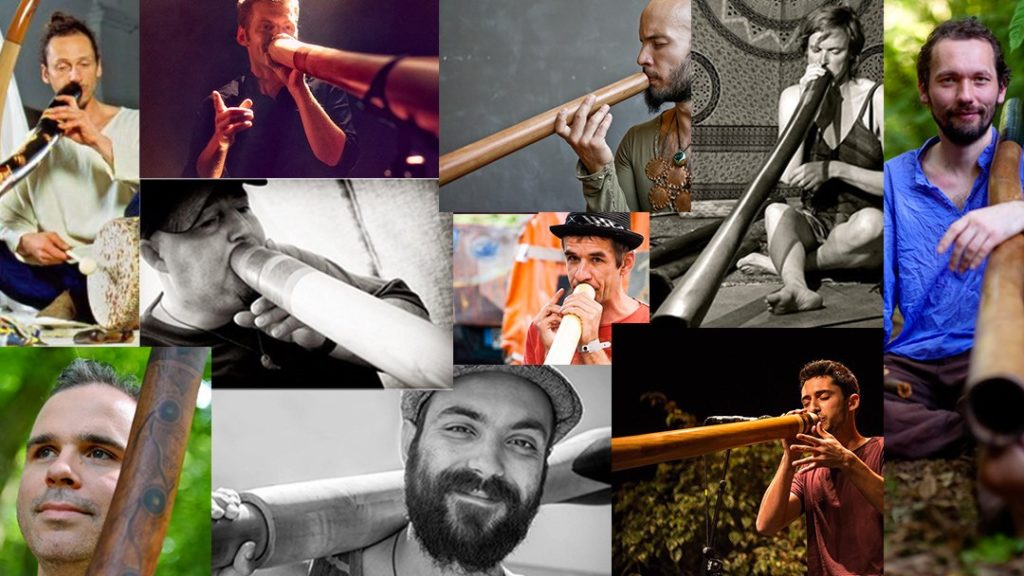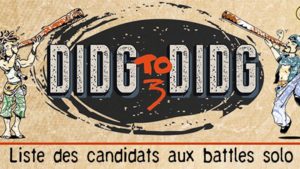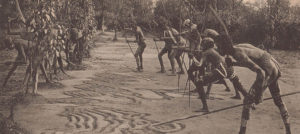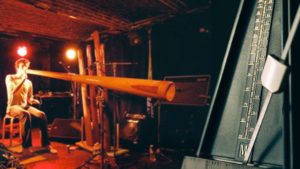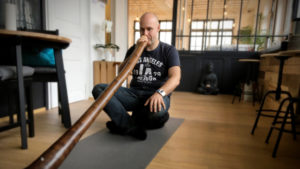Arriving in Europe in the 1980s, didgeridoo really took off in the following decade. In almost 30 years, this great piece of wood has seen the birth of many styles through players from all over Europe. Let’s go on a short tour of the old continent…
Each player and/or country has developed its own specialties, all of which blend a little bit more with each new generation. This article is not intended to introduce you to all the players, for obvious reasons, I cannot mention everyone here. But I would like to help the curious to discover the main players and styles of contemporary didgeridoo playing. Ready for a trip across Europe? Get your didgeridoo, the journey is on!
Didgeridoo in Dutch: diaphragm first and foremost!
At the end of the 90s, when the didgeridoo became widely known thanks to Jamiroquai and Wallis Buchanan, the Dutch were one step ahead of their European colleagues. Indeed, at that time the largest didgeridoo store in Europe opened in Amsterdam. Just that! It was one of the few places providing quality instruments at the time.
This dynamism has given players like Mark Atkins and Alan Dargin the opportunity to play and teach many players (see also: 10 Australian Didgeridoo Players You Should Know! ).
It is precisely thanks to them that Lies Beijerinck has been able to perfect herself and become “The Mother Didg of Holland” in the eyes of the contemporary world. Lies is naturally gifted in pedagogy, which allowed her to teach all over Europe. Through many of her courses, hundreds of players have learned the basic techniques of didgeridoo playing.
The Dutch style is a style based on “diaphragm” breathing (written “ON” in Wakatoo, it’s a card game I created to help didgeridoo player to understand rhythm, you can check it here!) and “jaw” breathing (WI) taught by Alan Dargin.
The drone is interspersed with overtones while being marked by a rather deep midrange voice. Finally, many Dutch people play the didgeridoos of Aborignal Art, which inevitably colors the game with a rather rough sound.
Didgeridoo player, Lies Beijerinck, with a hang pan.
Didgeridoo in Eastern Europe: A jerky game mixing pressure and voice
Do you know Ondrej Smeykal? One of my most memorable memories is of the “Le rêve de l’Aborigène” festival. I discovered Ondrej in 2007. He’s a Czech player. I remember Zalem telling me he had seen him in Switzerland and that he was blown away by his performance. And for good reason!
Ondrej developed a style of his own, so different from what was being done at the time. While in his first albums, he searched a lot for an over vibration/ bumblebee link supplemented with some vocals. He clearly has a contemporary research and performance approach. He told me one day that he would like to go on stage, roll a long sheet of paper and give his concert. Whether you like it or not, Ondrej is to be discovered! A few years later came Dubravko Lapaine, from Croatia. Dubravko learned the basics of the “eastern game” with Ondrej, but he didn’t stop there: he ended up finding his own way. The Dubravko thing? Playing on long didgeridoos, and when I say long, I mean very long! Some can reach up to 3 or 4 meters!
Dubravko’s style, although similar, is more distinct than Ondrej’s. It is based on very dry and jerky tongue attacks with overloads of pips pushed to the extreme.
Ondrej Smeykal solo
Dubravko Lapaine in the “Le rêve de l’Aborigène”
Didgeridoo in Italia: Will you have a little more tongue?
Italian players are quite rare. However, it should be pointed out that two of them have influenced (and still influence) Italy: Andrea Ferroni and Gianni Placido.
For the record, when I first met Andrea, it was in Airvault in 2004. I had made my little free scene and played my didgeridoo in a corner. He came with a friend and said to me, “We really liked what you played, would you be willing to come and play at the Italian didgeridoo festival? ». I was both enchanted by the demand and scared: I had only been playing for 2 years and imagining myself on a big stage still scared me a lot. I eventually found an excuse not to go… When the bird isn’t ready, it is better not to jump out of the nest!
But back to our two Italians… Today, Andrea is more discreet on the didgeridoo stage. Gianni Placido seems to draw more attention these days. Both play instruments with very thin conical shapes, which by extension develops a game based on tongue attacks and ‘wa’ tongue tips. In summary, a lot of tongue playing!
Andrea Ferroni at the Italian didgeridoo festival DidjinOZ
Gianni Placido
Didgeridoo in France: precision and beatbox
It is difficult for me to talk about the history of the French didgeridoo, because I am intimately involved in it. However, it can easily be said that the French game is more turned towards wobbles (fast breathing technique) and a clean sound. These are qualities that are found mainly in France. I have modestly promoted these two aspects. Indeed, at the time I was surprised to hear so little harmonics and clarity of sound. But it was that in particular which attracted me to didgeridoo.
Through the hazards of life, I started on a very short (1 meter long) and very wide F sharp (a hole of about 55mm), and you know what else? This type of instrument is ideal for harmonics (clear sound) and cheek play (Wobble). Life does things well sometimes!
Fast forward to around 2005, and French players started experimenting more and more Beat-box didgeridoo like Zalem, in rhythms highly inspired by electro music. But to give credit where credit is due, it is Kelu and Eyesful who really launched the Beat Box / didgeridoo movement.
NB: I do not list here all the French players, because there are simply too many of them. The French community being one of the most active in the world, I am preparing a more detailed and carefully thought article dedicated especially to the hexagon (at the risk of being chauvinistic!)!
The song “L’exil” with Pierre-Olivier Fernandez and myself 🙂
Kelu and his love for fast and strong rhythms!
Zalem Delarbre
Eyesfull
The Swiss: a unique community
The Swiss community is amazing, because it is not very large and yet there seems to be a certain dynamism in Switzerland. The Swizzeridoo festival for example, after a few years break, now takes place every year in Bern. In addition, some manufacturers and stores have been in place for more than ten years now and seem to be holding up well. Some Swiss names have greatly influenced the contemporary didgeridoo playing scene such as Denra Dürr (those who follow me know how much I love his game!) and Matthias Mueller.
Denra Dürr has withdrawn from the world of didgeridoo and seems no longer to give concerts or internships.
Matthias Mueller, a contemporary of Lies, is still very active and keeps a very strong link with Aboriginal culture. For 20 years now, he has been travelling to Arnhem Land every year. It should also be added that Matthias had started in 1999 in his album Passion to develop the first “out of vibration” sounds (later called Beat-box)! He was rather ahead of his time!
Matthias muller
The only track by Denra Dürr on the internet
The Belgians
Having lived three years in Brussels, Belgium does not leave me indifferent… The players’ meetings are held in the form of informal meetings, with people gathering around the didgeridoo, with some enthusiasts trying to pass on the thrill of playing throughout the country. There is also a Belgian online forum where announcements are posted regularly.
If you go through Brussels, you can contact Termita-didjes, a store (mainly online) that sells mostly Yidakis. Amongst the most notable Belgian players, we have: Grégoire de Ryckel (who influenced me a lot at my beginnings!), Nicolas Fourré, Gauthier Delsipee, Olivier Richir, Mirko Bozzetto and Magic Wood (Olivier Richard).
Mirko Bozzetto – The Borderless Project
Nicolas Fourre
Gauthier Delsipee
The Germans
Didgeridoo had its golden age in Germany in the late 1990s. When I started, I heard that at its best, no less than 5 didgeridoo festivals had been created in the country!
Since then, the German didgeridoo playing scene has been rather calm. However, we regularly meet three names in didgeridoo festivals: Marc Miethe, Frank Heinkel and Tom Fronza.
All three have their own style. There was also Stephan Gög who did some good songs at one time but, unless I’m mistaken, who doesn’t seem to play anymore.
Franck Heinkel
Gög
Mark Miethe
Tom fronza
The Austrians
Austrians also have their own style. They use thin and conical didgeridoos, sometimes made of fiberglass, and their playing style tends to be phrasing based on many attacks. Ansgar Stein and Ali Andress are two members of the (slightly) crazy group Aara. As for Markus Meurer, I think I am not mistaken in saying that he was greatly influenced by Lies Beijerinck. He tours a lot with his band Airtist, a mix of Beatbox and didgeridoo.
Ansgar Stein
Ali andress
Aara, the group that takes on its offbeat side!
Markus Meurer with his group Airtist
The English: a prolific generation!
Mike Edward was, at the time I started, the most famous English player in the world, with his formidable tongue game and his endless excitement. They had, with Mickael Jackson (homonym of the singer!), impressed the didgeridoo community with their speed and the number of over vibrations played per minute!
(EDIT)
However, Mike Edward was not the only Englishman to influence contemporary didgeridoo playing. Stephen Kent in his comment at the bottom of this article reminded me of a lot of players to name, thanks to him!
Let’s start with Stephen Kent him-self, who lived in the United States for more than 20 years. He has greatly influenced the European (and world) scene with his round and bouncy playing. Another great player is Wallis Buchanan who made thousands of people want to blow into a piece of wood with his song with Jamiroquai “A journey in Arnhem Land”.
And finally, Graham Wiggins (also known as Dr. Didg) was one of the players with a separate rhythmic placement. He had an ability to combine his didgeridoo with other instruments with great ease.
Today, it seems that the community of traditional players is much more active in the United Kingdom, reducing the interest of the modern didgeridoo. I have had the opportunity to travel to England three times to play and teach. The English have a little defined play in the phrasing that gives them a round sound, sometimes a little too much for my taste.
Stephen Kent and his mythical solo!
Mike Edwards and his great overtones!
Graham Wiggins alias Dr. Didg
Wallis Buchanan, discovered thanks to Jamiroquai!
The Spanish and Portuguese: neighbors of the French
I quote these two countries together, because they are both very influenced by France. Could it be our Latin roots that bring us closer to the didgeridoo game? When you see how language influences didgeridoo playing, there is a good chance! Whatever the case may be, wobbles and clear sounds have been well exported to southern Europe.
Several names stand out, most of them from a new generation of players. A quick nod to the Portuguese community, which seems to be in one of the most dynamic movements in Europe.
The players to remember for Portugal are Tiago Francisquinho, João Jardim, Renato Oliveria and Rodrigo Viterbo.
In Spain, we can mention: Senor Marküsen (Spanish living in Berlin), Iban Nikolaï, Carlos Cattano and Rodrik.
Senor Merküsen
Iban Nikolai
The trio Joao, Tiago and Renato
Carlos Cattano and his group Shantijaz
Rodrik
Rodrigo Viterbo
Conclusion: Europe is writing its own didgeridoo history
I hope I helped you discover the landscape of the European didgeridoo playing scene, with its eastern game, its wobbles and its French beatbox, but also and especially the particularities of each player. The history of contemporary didgeridoo playing is still young and there is still much to be experienced and built. We are all a part of it, each in our own way. And it is by keeping everyone playing that the rest of the story will write itself. So have a good breath, folks!
And if you know of any names I wouldn’t have mentioned, feel free to share them here (I remind you that French players will be the subject of a very special article!). If you liked the article, please consider sharing it!


